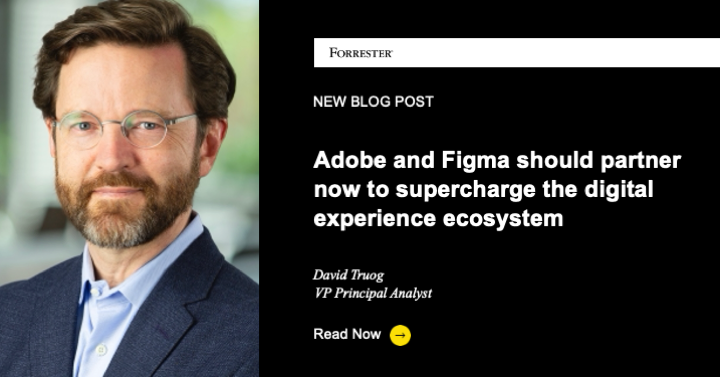It was a setback for businesses and consumers on Monday when Adobe and Figma terminated the proposed merger that they’d announced last year. But the reason they broke off the engagement was not a change of heart — it was because regulatory bodies in the UK, the EU, and the US signaled such opposition to the marriage that the prospects of getting the overseers’ blessing were dimming beyond hope. (Most of the opposition was rooted in insufficient understanding of how software is made — but that’s now water under the bridge.)
This scuttling of their own deal won’t be the end of the Adobe-Figma story, though. The next chapter must be about close partnering instead. The termination announcement contained only one mention of partnering — and a lukewarm one at that (“[We] will look for ways to partner to delight joint customers in the future”). But the right kind of partnership would yield abundant benefits for:
- Both Adobe and Figma, because they hold unique leadership positions in their respective markets.
- The millions of businesses that create apps and websites for their customers and employees.
- The billions of customers and employees who engage with those organizations’ apps and websites.
- Other technology providers that, like Adobe and Figma, equip those businesses with tools for conceiving and creating apps and websites.
Figma Is Dominating The Digital Experience Creation Process
Figma lets organizations conceive and create digital experiences better and faster. In other words, it helps them design software, including apps and websites, more effectively and efficiently, especially in the strategically crucial early stages of the process: hatching concepts, formulating flow logic, defining an information architecture that fits with users’ mental models, structuring interactions, and deciding how to represent all of that visually. The resulting artifacts serve as a single source of truth not only for designers but for other crucial stakeholders — including developers, who make up a third of Figma’s user base — to rely on.
Unfortunately, Adobe and Figma refer to this as “product design” — a tech industry jargon idiom that confuses regulators, Wall Street, and many others because 1) it uses “product” as a synonym for “software” and 2) the term “design,” in the minds of most of these industry outsiders, evokes only tasks like picking colors and typefaces, even though those are only a tiny fraction of what design is about.
But although the “product design” idiom contributed to regulators’ misunderstandings and is slowing mainstream cross-enterprise spread of Figma, the platform’s innovative strengths are driving its advance nonetheless. It leads the market in terms of enabling teams to conceive software collaboratively in real time and is making bold strides to address more of the needs of software developers and to add generative AI capabilities (as I described in this post about Figma’s most recent Config conference).
Adobe Dominates In Product Breadth And Depth And Through AI Leadership
Meanwhile, Adobe’s well-known product portfolio is pervasive across enterprises for creating most of the assets that are the foundation of digital experiences, from images and 3D assets to audio and video. It also has a yearslong history of infusing its tools with AI capabilities (branded as “Sensei”). And this year, the company has aggressively established a generative AI (genAI) leadership position with Firefly, its ready-for-business genAI service for creating assets from prompts in a manner that is commercially safe. Adobe is cementing and expanding that genAI leadership into other mediums (as I described in this post about Adobe’s MAX conference in October).
Adobe And Figma Should Seize The Opportunity To Lead The Ecosystem
Adobe’s and Figma’s strengths are complementary, but the two companies have a long way to go to enable smooth interoperability and round-tripping between their respective products. Does it make sense for the two companies to partner to achieve this despite not merging after all? Yes, because:
- Excellent interoperability will help both Adobe’s and Figma’s customers. In contrast, if they were to choose to evolve toward becoming direct competitors (for example, if Adobe revived its Project Spice*), they would prove that the regulators were right after all.
- The two companies’ leadership positions mean that they have the power to define interoperability standards that the rest of the ecosystem will embrace.
Forrester has predicted that tools and platforms used for various aspects of the overall design workflow — such as prototyping, design system management, and visual collaboration — would converge. We believe this convergence will happen through a mixture of some outright acquisitions and some close partnerships. The next chapter in the Adobe-Figma story has enormous potential to advance that convergence significantly.
Let’s Connect
If your company has expertise to share on this topic, feel free to submit a briefing request. And if you’re a Forrester client and would like to ask me a question about the topic, you can set up a conversation with me. You can also follow or connect with me on LinkedIn if you’d like.
*According to the UK’s Competition and Markets Authority’s Summary of provisional findings (28 November 2023), “Adobe reduced its engineering resourcing of Adobe XD and shifted these resources to Project Spice … [which] was intended to be a web-based tool with product design capabilities that would compete more strongly with Figma … The Parties submitted that Adobe XD was placed in ‘maintenance mode’ in February 2022. They also submitted that Project Spice was not the successor of Adobe XD and was not going to become a product design tool, and that Project Spice was cancelled for reasons unrelated to the Merger. Finally, the Parties submitted that Adobe has effectively exited the market for product design software and does not have the ability and incentive to re-enter organically.”








